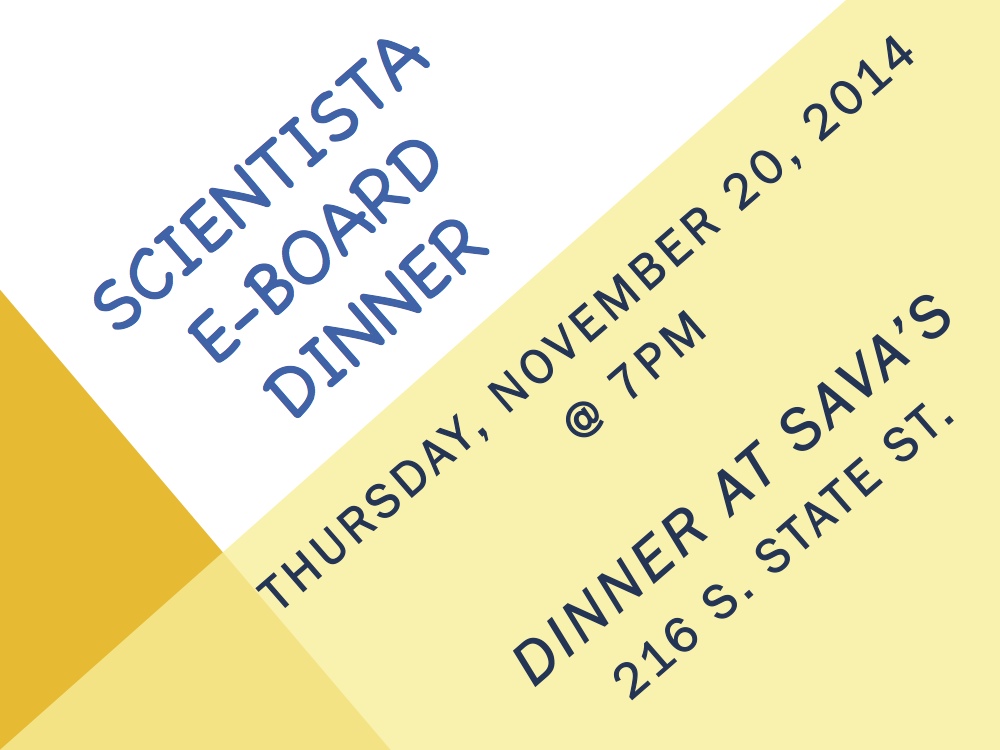|
11/19/2014 0 Comments Fall Executive Board Dinner EventAll UMichigan Scientistas are invited to join the executive board this Thursday, November 20 for our fall executive board dinner. Feel free to come to our New Board Member Orientation at 6pm before the dinner in Room 1152 of the Shapiro Library (Brainstorming Room). Scientistas will have the opportunity to speak with our current executive board members and meet new board members of the UMichigan family. The dinner begins at 7pm at Sava's on 216 S. State St. The executive board looks forward to your attendance at the dinner on Thursday.
0 Comments
 By Alyson Rich No. If you thought that humans only use 10 percent of their brain, don’t feel bad because Hollywood got it wrong, too. The plot of the 2014 movie Lucy is that a woman named Lucy (Scarlett Johansson) is unwillingly exposed to a drug that allows her to unlock more than 10 percent of her brain. The movie then follows her progression as she exacts revenge on her kidnappers, all the while gaining access to more and more of her brain. An interesting story, but the science behind it is all wrong. Even when resting, your brain is still hard at work. According to neurologist John Henley from the Mayo Clinic, “evidence [from brain imaging studies] would show over a day you use 100 percent of the brain”. This does not mean that all of the brain is active all of the time. That would be like living in a gigantic mansion and paying for every room to be heated, including the ones that are rarely used. The human body has evolved to be cost-efficient because even the most basic tasks require a surprisingly large amount of energy. Some may point out that as our systems gain this energy through ingesting and digesting, we should simply eat more. Problem solved? Nope, because bringing in and breaking down food also requires energy. It is one of those “two steps forward, one step back” situations. As it is not practical to spend all our time eating, we force our bodies to prioritize sustaining only the areas that are relevant to current or impending tasks. From reading this you can now honestly declare that you know something Albert Einstein did not. Einstein believed the myth, and explained his intellect by claiming that he could access more than the standard 10 percent. For a different explanation debunking this myth, watch the attached video: For more information, go to: http://www.scientificamerican.com/article/do-people-only-use-10-percent-of-their-brains/
11/8/2014 0 Comments Maternity Leave By Boseong Yun The Washington Post recently reported on the grim realities of maternity leave. According to “On maternity leave? You may face lending bias, HUD says” by Emily Wax in the Washington Post, banks are reluctant to give loans to female workers on maternity leave. For instance, the U.S. Department of Housing and Urban Development launched 15 maternity leave discrimination investigations and 173 allegations against lenders. These show that there are abundant cases of official maternity leave discriminations in the United States. These maternity leave discriminations are all the more problematic, because securing a mortgage is vital to buying a house for the family. Without the mortgage, people face difficulties facing affording a house. Another reason why it is problematic is because a significant number of women are devoted to the labor force, enlarging the sexual inequalities and economic consequences. For instance, the article reveals that, “…50 percent of women return to work within three months after giving birth, more than 70 percent of mothers with young children are in the workforce and four in ten mothers are the sole or primary breadwinner for their families.” These show that maternity leave discriminations have bigger economic consequences, increasing the economic dimension of sexual inequality. Economy is a necessity for leaving, and pregnancy is a biological reality. That is to say, the current lack of social conditions for female workers are economically detrimental for them. Choosing to getting married and having a daughter or son is incompatible with the structures of the society for female workers. Simply having a son or a daughter may risk a mother having access to housing. With the increasing number of female workers, this maternity leave discrimination means more economic dimensions of sexual inequality problems in an era where economic power is a quintessential necessity for living.  By Claire Wiggins Obesity is becoming a growing problem worldwide, but especially in the United States. Packing on these excess calories has been linked to numerous diseases, including heart disease, diabetes, and Alzheimer’s disease. As the traditional diet plans are statistically ineffective, researchers have been investigating new ways for effective weight loss. A team of researchers from the University of Bonn in Germany has recently made leaps towards this goal, discovering a new way to burn energy by stimulating brown fat. There are two main classes of fat in animals: white fat, which swell as excess weight is added, and brown fat, which work to provide heat to the body, burning up excess calories. According to Professor Alexander Pfeifer from the Institute of Pharmacology and Toxicology at the University Hospital Bonn, "If we are able to activate brown fat cells or to convert white fat cells into brown ones, it might be possible to simply melt excess fat away." The key to this new study is the use of adenosine: a signaling molecule that is typically reduced when the body is under stress. When the researchers induced the production of brown fat A2A receptors in white fat cells, they started turning into brown fat cells when exposed to adenosine. Even though clinical applications are still far off, this study is a promising beginning to a potential treatment of obesity in the future. Research link: http://www.sciencedaily.com/releases/2014/10/141016085652.htm 11/6/2014 0 Comments Games Are the Future of Our World By Jennifer Wardell More than 174 million Americans are gamers, and by the age of 21 children in the United States will spend a total of ten thousand hours gaming! Now you're probably thinking that playing video games is bad for you, and we need to tell these children to stop staring at screens, but Jane McGonigal says otherwise. She believes that video games actually fulfill human needs, therefore causing less regrets at the end of our lives. Plus, we can use games to change the way we act in the real world. Jane McGonigal is a designer of alternate reality games, and she has a mission of seeing a game developer win the Nobel Peace Prize. She has created games in more than 30 countries, partnering with many organizations to create games that challenge players to tackle real world problems. One of her best known games is called "SuperBetter". This game helps people tackle a variety of problems, especially anxiety and depression. Initially, Jane McGonigal developed this game for herself in order to help her get over a concussion that didn't heal correctly. It helped her to get better and tackle the real world by making her more confident, and she was able to get in a network of friends that could help her. In addition to helping people tackle health issues, she also believes that games contribute to human happiness and motivation, and give one a sense of meaning and community. Games help someone spend time with friends and family and to take a break from the stresses in the world. She believes that gamers will be able to tackle obstacles in real life and stay optimistic in the face of failure because of what they have experienced in games. Source: http://janemcgonigal.com
11/6/2014 0 Comments Splenda isn’t so Splendid By Jenny Gong Splenda. Truvia. Sweet’N Low. These companies are famous for making artificial sweeteners that are healthy alternatives to sugar. Every year, millions of Americans consume about 130 pounds of sugar per year. Artificial sweeteners aim to change that. Artificial sweeteners are synthetic substitutes for sugar that are typically made from natural substances. Many view them as healthy alternatives; they combat weight gain as they add virtually no calories to your diet and they can prevent diabetes and generally do not raise blood sugar levels. Despite these health benefits, a new study reveals that these artificial sweeteners may be doing more harm than good. Dr. Elinav and his team found that when they fed mice these artificial sweeteners for a prolonged period of time, the mice developed intolerance to glucose. Glucose intolerance is a condition where a body is unable to digest large amounts of sugar and can be a precursor to a more serious disease, type 2 diabetes. The research team found that this change in glucose metabolism was actually caused by a change in gut bacteria. When they tested this in humans that normally did not ingest artificial sweeteners, the patients began to show signs of glucose intolerance as well as a changed microbiome. Thankfully, researchers were able to reverse the glucose intolerance in both humans and mice through administration of antibiotics. While there is still much more research to be done, the study gives a warning as to the effects of artificial sweeteners. However, not all artificial sweeteners seem to have this effect; sweeteners like Splenda contain only 13% of natural sweetener substances, but those that have higher percentages of natural substances tend to be healthier. In the end, in a very ironic twist of fate, the very things that can prevent one type of diabetes may actually lead to the other type. Source: http://well.blogs.nytimes.com/2014/09/17/artificial-sweeteners-may-disrupt-bodys-blood-sugar-controls/ 11/4/2014 0 Comments Food: A Dangerous Drug? By Chetali Jain Marijuana, Cocaine, Alcohol, Tylenol, Valium—these substances are typically what comes to mind when we hear the word ‘drug.’ But by definition a drug is anything we ingest or absorb that has a physiological effect on our bodies. This makes food the most predominant drug (besides air or water, of course) on this planet. Good food has the power to cure all kinds of debilitating diseases that plague our society: diabetes, cancer, depression, and so on. With this high comes a dangerous low, however. Bad food can devastate the internal balance of an organism. So what defines a good or bad food? The answer goes so much further than to simply say processed food is bad and natural food is good. The majority of people believe that a grilled chicken sandwich or scrambled eggs is a health-conscious dietary choice, but they would be wrong. Many studies have proved the negative effect that animal proteins have on the human body. According to Dr. John McDougall, “Protein, fat, cholesterol, methionine (a sulfur-containing amino acid), and dietary acids, which are all superabundant in animal foods, are poisoning nearly everyone following the standard Western diet.” Animal by-products are especially acidic and, on the scale they are being consumed, detrimental to overall health of an individual. Eliminating all animal proteins from your diet will eliminate the five aforementioned components in animal foods which would benefit your body. There are countless testimonials of people with incurable, hopeless diseases who live normal and healthy lives because they shifted to a Vegan, plant-based diet. Reports of increased energy, lower blood sugar and/or cholesterol, overall improvement in function are commonly witnessed with the change to Veganism. It is difficult in today’s society to be Vegan, no doubt about that, but the more enlightened the population becomes, the more accepted Veganism will be. Are you ready to make the switch? Sources: https://www.drmcdougall.com/misc/2010nl/jan/poison.htm http://drhyman.com/blog/2013/05/17/the-one-diet-that-can-cure-most-disease-part-i/#close  By Angie Miller Detail oriented? Persistent? Work well in a laboratory? Can solve complex problems? Chemical engineering is a branch within the engineering field. The job growth for chemical engineers in the next 10 years is slow at a predicted 3-6% increase. The median salary of a chemical engineer in the United States is $92,930. From increasing the efficiency of production of chemicals and biochemical to designing and manufacturing equipment as well as testing and conducting research, chemical engineers apply the principles of chemistry to solve every day problems. Work environment for chemical engineers is usually a 40-hour week at industrial plants, buildings, or laboratories. Generally, chemical engineers perform tests, continue research, and design or plan specific materials or processes to be more effect for the company. Education is focused on classes with a variety in mathematics, science, and English with additional engineering courses. Undergraduate degrees typically last 4 to 5 years. Even though most entry-level chemical engineering jobs only require a bachelor’s degree, chemical engineers focused in research and high-level jobs combined with changing technology may require a graduate degree. Personality skills that are important for chemical engineers include analytical, detail oriented, patient, and being able to communicate well both through writing and orally. Similar careers to chemical engineers are nuclear engineers, soil and water conservationists, and geoscientists. Source: http://www.sciencebuddies.org/science-engineering-careers/engineering/chemical-engineer#keyfactsinformation By Cameron Goodman
If you aren’t living under a rock, and go on any social media/ read any news sources, you would have heard about the Ebola outbreak. This deadly disease is the talk of many conversations on campus and there is a reason why. What is Ebola? It is a deadly virus, which spreads through the body and causes uncontrollable bleeding. It is also called Ebola hemorrhagic fever or Ebola virus disease. It has 5 different virus strains, 4 that cause the illness in human beings. The believed animal reservoir is fruit bats. It is called Ebola because one of the first cases broke out near the Ebola River in Africa. Why is Ebola scary? There are very high death rates, on average 50%, ranging from 2-90% dead from infection of this disease. This is considered to be the new HIV/AIDS because neither have a cure. Humans transmit this through contact with any bodily fluid and likely an object that has been exposed as well. How do you know if you have Ebola? Symptoms include headache, sore throat, fever, fatigue, and stomach pain. When the disease worsens bleeding internally and externally, diarrhea, and vomiting occur. Symptoms for this disease might not show up until 2-21 days of being infected because there is an incubation period (time elapsed between exposure of disease and when symptoms happen), but usually show up within 8 to 9 days after exposure. Humans are only infectious when they have symptoms! How do you prevent and control Ebola? Knowledge is key: spreading awareness and knowing how to protect yourself will help lower human transmission. Those who come in contact with someone with Ebola must wear personal protective equipment and wash their hands frequently. Also, the health of those who may have been in contact with the disease will be monitored for 21 days (in the United States). Where has Ebola been found? This recent outbreak, since March, has been found in Guinea, Liberia, Sierra Leone, Nigeria, Democratic of the Congo, and Senegal. Six people from United States have been infected with Ebola. One person from the United States, Thomas Eric Duncan, has died. These facts have just been the basics of this disease, and to learn more go to: http://www.who.int/mediacentre/factsheets/fs103/en/ 11/3/2014 0 Comments The Panamanian Golden Frog By Katie Beth Halloran These frogs are one of the few amphibians with their own national holiday: National Panamanian Golden Frog Day. There’s even a parade. The frogs are so popular not only because they are supposedly lucky, but because of their cheerful coloration and mannerisms. The frogs are bright yellow and have two different whistling calls. They lack a typical eardrum, and expand their linguistic capabilities through sign language, by waving their forelimbs. They wave to defend territory, they wave to attract a mate, they wave to say hello to their neighbors. Both males and females wave. The waving is linked to their walking pattern, and is thought to be an evolved embellishment of a normal frog walk.  The frog might look sunny, but are close cousins of poison dart frogs, and secrete highly toxic compounds. The golden frog’s poisons are so unique and dangerous that it was recently placed in a separate taxonomic group. Froglings don’t secrete the toxins which guard the adults, and must hide to protect themselves. The young aren’t guarded by their parents, and large numbers die before they reach adulthood. The parents lay their eggs in dark underwater crevasses to protect them from harmful UV light. When the tadpoles hatch, they eat algae off the surfaces of rocks using their beaks. They also use their strong mouths to cling to rocks in areas with a fast current. Despite their ferocious gesticulating and deadly poisons, this frog is critically endangered due to rain forest development and the chytrid fungus. Researchers are looking into how pollution might be weakening the frog’s immune response to this fungus, and the Panama golden frog is being conserved in captive breeding programs such as EVACC until immunity can be bred into its population. Sources : http://link.springer.com/article/10.1007/s100710050012#page-1 http://www.zooatlanta.org/panamanian_golden_frog#reZ7w http://animals.sandiegozoo.org/animals/panamanian-golden-frog EVACC- https://www.flickr.com/photos/amphibianavenger/sets/72157629587526014/# |
WELCOME, UMICH SCIENTISTAS!
CAMPUS PICS
WHAT'S NEWUPCOMING EVENTSPAST POSTS
October 2022
SORT BY TAG |
The Scientista Foundation, Inc. All Rights Reserved © 2011-2021 | Based in NY | [email protected]
The Network for Pre-Professional Women in Science and Engineering
The Scientista Foundation is a registered 501(c)(3) -- Donate!
The Network for Pre-Professional Women in Science and Engineering
The Scientista Foundation is a registered 501(c)(3) -- Donate!



 RSS Feed
RSS Feed